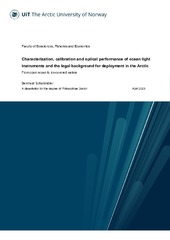Sammendrag
While commercial light instruments can measure high and medium light intensities, there are few that can capture the low light conditions, consisting of light from moon, stars and aurora, that prevail during the (polar) night. In the ocean, light intensities are even lower because of the high absorption of water, optically significant constituents and phytoplankton. In polar regions, snow and sea ice can reduce the light in the ocean even further to a fraction of the light intensities at the surface. Still, even these low light intensities are sufficient to act as a cue for biological processes e.g. diel vertical migration of zooplankton. This illustrates the need for sensitive light instruments.
However, for measurements to be useful these need to be of sufficient quality. The focus of this thesis is the development of characterization and calibration methods for two ocean light instruments. The first one, the Optical Chain and Logger (OptiCAL) is an autonomous ice-tethered observatory consisting of a buoy and a cable that can host up to 32 light instruments, providing depth resolved light measurements. The second one is a commercial underwater hyperspectral imaging (UHI) instrument that can provide angle-resolved radiance measurements and hyperspectral images.
To maximize the range of potential users, the developed calibration methods use simple setups that have potential to be replicated at many institutions. In addition, the interdisciplinary part of this thesis discusses three different platforms for collecting scientific data in the marine arctic and the applicable legal framework, which is a prerequisite for carrying out the research. This is especially relevant in times of increasing autonomous data collection.
Mens kommersielle lyssensorer kan måle høye og middels lysintensiteter, er det få som kan måle i tilnærmet mørke og i miljøer karakterisert av lave lysforhold. Et godt eksempel på dette er den arktiske polarnatta der lys fra måne, stjerner og nordlys dominerer, og i havet på relativt dypt vann. I polare strøk kan snø og havis redusere lyset i havet ytterlige til en brøkdel av lysintensiteten ved overflaten. Likevel er selv disse lave lysintensiteter tilstrekkelige til å styre biologiske prosesser som f.eks. vertikal migrasjon av dyreplankton. Dette illustrerer behov for følsomme lysinstrumenter.
Men for at målinger skal være nyttige, må disse være av tilstrekkelig kvalitet. Denne avhandling fokuserer på utvikling av karakteriserings- og kalibreringsmetoder for to lysinstrumenter som brukes for å måle lyset i havet. Den første, som heter Optical Chain and Logger (OptiCAL) er et autonomt isbasert observatorium som består av en bøye og en kabel som kan bære opp til 32 lysinstrumenter, som gir en høy opplysning av lysmålinger med dybde. Den andre er et kommersielt Underwater Hyperspectral Imaging (UHI) instrument som kan gjøre lysmålinger over mange vinkler samtidig og gir hyperspektrale bilder.
For å nå mest mulige brukerne, bruker de utviklede kalibreringsmetoder enkle oppsett/utstyr som er tilgjengelig ved de fleste institusjoner. Den tverrfaglige delen av denne avhandling diskuterer tre ulike plattformer som brukes for innsamling av vitenskapelig data i polhavet og gjeldende juridisk rammeverk, som er en forutsetning for å gjennomføre forskningen. Dette er spesielt relevant i tider med økende autonom datainnsamling.
Har del(er)
Paper I: Woker, H., Schartmüller, B., Dølven, K.O. & Blix, K. (2020). The law of the sea and current practices of marine scientific research in the Arctic. Marine Policy, 115, 103850. Also available in Munin at https://hdl.handle.net/10037/18115.
Paper II: Schartmüller, B., Anderson, P., McKee, D., Connan-McGinty, S., Kopec, T.P., Daase, M., Johnsen, G. & Berge, J. (2023). Development and calibration of a high dynamic range and autonomous ocean-light instrument to measure sub-surface profiles in ice-covered waters. Applied Optics, 62(31), 8308-8315. Also available in Munin at https://hdl.handle.net/10037/32006.
Paper III: Schartmüller, B., McKee, D., Berge, J. & Johnsen, G. (2024). Calibration verification of an underwater hyperspectral imaging push broom instrument to measure light in absolute units and field demonstration. Applied Optics, 63(27), 7200-7211. Also available in Munin at https://hdl.handle.net/10037/35055.


 English
English norsk
norsk
